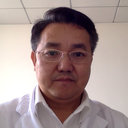Diagnosis and treatment of giant cell granuloma of the temporal bone: Report of eight cases.
Açar sözlər
Mücərrəd
Abstract Conclusions: It is impossible to make a diagnosis of temporal giant cell granuloma (GCG) before operation because of nonspecific clinical and imaging feature. Surgery is the first-line choice of treatment.
OBJECTIVE
To evaluate the diagnosis and treatment of temporal GCG.
METHODS
Eight patients with GCG receiving treatment in the Chinese PLA General Hospital between 2001 and 2010 were recruited for the study. These patients' clinical features, imaging and histopathological findings, types of surgery, and results of follow-up evaluations were noted.
RESULTS
The group was made up of four males and four females, with a median age of 37 years (range 21-50 years). Four patients had a granuloma on the left side and four on the right of the head. The median duration of the disease was 21 months (range 5-60 months). All patients, except one referred to us for recurring disease, were managed in our hospital. The main symptoms were: hearing loss (n = 5), tinnitus (n = 4), otalgia (n = 3), dizziness (n = 2), and local masses (n = 2). Radiological examination of the masses revealed erosion of the temporal bone and base of the skull. There was no definitive diagnosis in any of the patients before surgery. All patients had surgical treatment, six of them by middle cranial fossa approach and two by combined cranio-auricular approach. Surgical complications included partial facial paralysis (three cases) and cerebral edema (one case) but they resolved soon after surgery. One patient was lost to follow-up, but the other seven were followed up over a mean period of 24 months; none has reported a recurrence.


